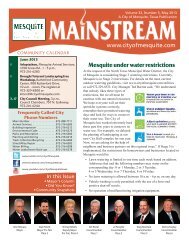airport/documents/Mesquite Master Plan Final.pdf - The City of ...
airport/documents/Mesquite Master Plan Final.pdf - The City of ...
airport/documents/Mesquite Master Plan Final.pdf - The City of ...
You also want an ePaper? Increase the reach of your titles
YUMPU automatically turns print PDFs into web optimized ePapers that Google loves.
user fees, taxes on airline tickets,<br />
aviation fuel, and various aircraft parts.<br />
Funds are distributed each year by the<br />
FAA from appropriations by Congress.<br />
A portion <strong>of</strong> the annual distribution is<br />
to primary commercial service <strong>airport</strong>s<br />
based upon enplanement (passenger)<br />
levels. If Congress appropriates the full<br />
amount authorized by Vision 100,<br />
eligible general aviation <strong>airport</strong>s could<br />
receive up to $150,000 <strong>of</strong> funding each<br />
year in Non-Primary Entitlement<br />
(NPE) funds (National <strong>Plan</strong> <strong>of</strong><br />
Integrated Airport Systems [NPIAS]<br />
inclusion is required for general<br />
aviation entitlement funding). In the<br />
first three years <strong>of</strong> the program under<br />
AIR-21, <strong>Mesquite</strong> Metro Airport was<br />
eligible for and received the full<br />
$150,000 in NPE funds. When the<br />
NPIAS was updated in 2005, it only<br />
included $333,333 in improvements for<br />
<strong>Mesquite</strong> Metro Airport for the next five<br />
years. This means that for FY 05 and<br />
until the NPIAS is updated again in<br />
2009, <strong>Mesquite</strong> Metro Airport is only<br />
eligible for $66,667 annually.<br />
<strong>The</strong> remaining AIP funds are<br />
distributed by the FAA based upon the<br />
priority <strong>of</strong> the project for which they<br />
have requested federal assistance<br />
through discretionary apportionments.<br />
A National Priority Ranking System is<br />
used to evaluate and rank each <strong>airport</strong><br />
project. Those projects with the highest<br />
priority are given preference in funding.<br />
<strong>The</strong> state’s federal funding allotment<br />
must be distributed to many <strong>airport</strong>s<br />
each year. As a result, TxDOT will<br />
typically limit the size <strong>of</strong> grants given to<br />
a single <strong>airport</strong> sponsor to ensure<br />
adequate funding for the state <strong>airport</strong><br />
6-9<br />
system as a whole. Thus, the costs <strong>of</strong><br />
implementing the runway extension<br />
may require the <strong>City</strong> to attract<br />
discretionary funding assistance.<br />
STATE FUNDING PROGRAM<br />
<strong>The</strong> State <strong>of</strong> Texas participates in the<br />
federal State Block Grant Program.<br />
Under the State Block Grant Program,<br />
the FAA annually distributes general<br />
aviation state apportionment and<br />
discretionary funds to TxDOT. <strong>The</strong><br />
state then distributes grants to state<br />
<strong>airport</strong>s. In compliance with TxDOT’s<br />
legislative mandate that it “apply for,<br />
receive, and disburse” federal funds for<br />
general aviation <strong>airport</strong>s, TxDOT acts<br />
as the agent <strong>of</strong> the local <strong>airport</strong> sponsor.<br />
Although these grants are distributed<br />
by TxDOT, they contain all federal<br />
obligations.<br />
<strong>The</strong> State <strong>of</strong> Texas also distributes<br />
funding to general aviation <strong>airport</strong>s<br />
from the Highway Trust Fund as the<br />
Texas Aviation Facilities Development<br />
Program. <strong>The</strong>se funds are appropriated<br />
each year by the state legislature. Once<br />
distributed, these grants contain state<br />
obligations only.<br />
<strong>The</strong> establishment <strong>of</strong> a CIP for the state<br />
entails first identifying the need, then<br />
establishing a ranking or priority<br />
system. Identifying all state <strong>airport</strong><br />
project needs allows TxDOT to establish<br />
a biennial program and budget for<br />
development costs. <strong>The</strong> most recent<br />
TxDOT CIP, Aviation Improvement<br />
Program 2006-2008, assumed that<br />
approximately $22 million in annual<br />
federal AIP grants, which includes $17




